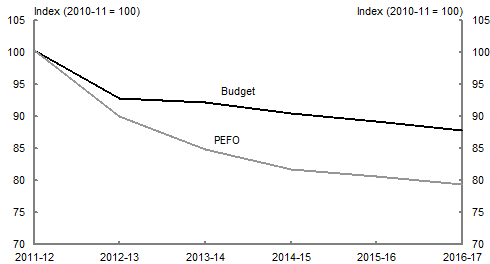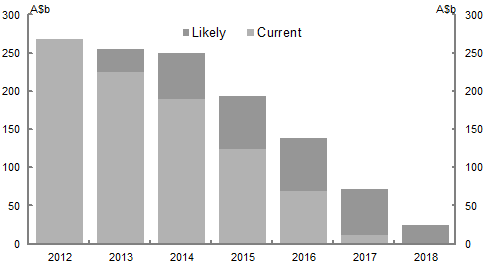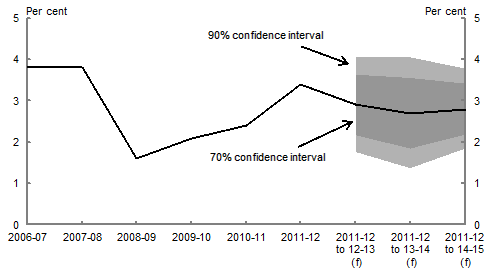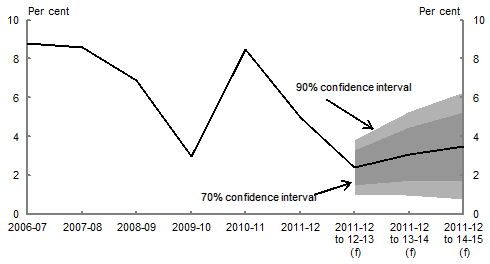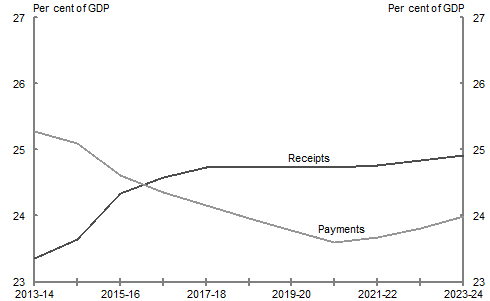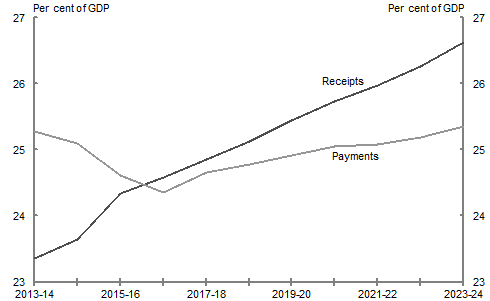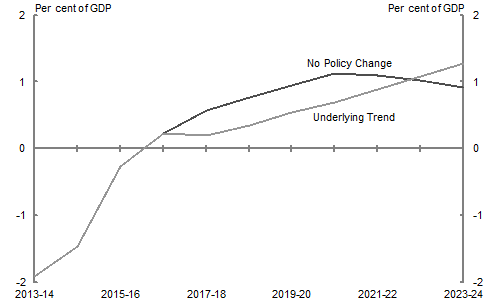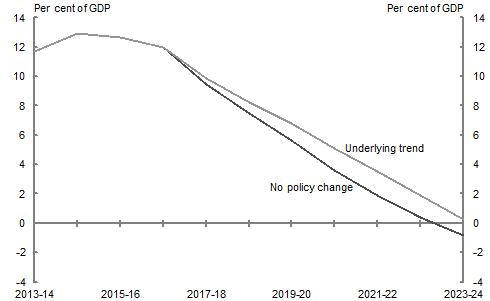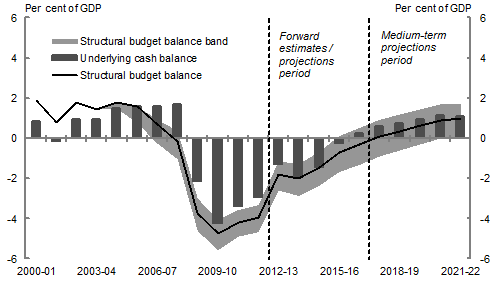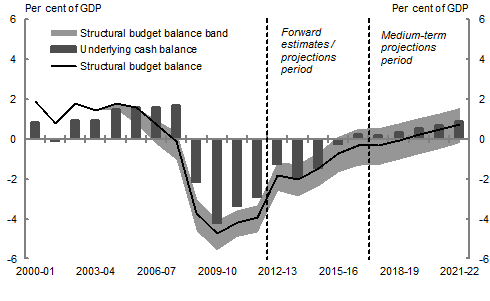Economic Outlook
Source: ABS cat. no. 5206.0 and Treasury.
This chart plots the Pre-Election Economic and Fiscal Outlook forecast for the level of Australia's terms of trade from 2011-12 to 2016-17 against that forecast in the 2013-14 Budget.
| 2011-12 | 2012-13 | 2013-14 | 2014-15 | 2015-16 | 2016-17 | |
|---|---|---|---|---|---|---|
| Budget | 100.3 | 92.9 | 92.2 | 90.5 | 89.2 | 87.8 |
| PEFO | 100.3 | 89.9 | 84.9 | 81.7 | 80.5 | 79.3 |
Box 1
Chart B: Outlook for resources projects
Source: Bureau of Resources and Energy Economics.
This chart plots the Bureau of Resource and Energy Economics' projection of the pipeline of resources projects under construction. The pipeline is expected to decline from over $250 billion in 2012 to less than $50 billion in 2018.
| 2012 | 2013 | 2014 | 2015 | 2016 | 2017 | 2018 | |
|---|---|---|---|---|---|---|---|
| Current | 268 | 225 | 190 | 124 | 69 | 12 | 0 |
| Likely | 0 | 30 | 60 | 70 | 70 | 60 | 25 |
Box 2
Chart A: Real GDP growth rate
Note: The central line shows the outcomes and PEFO forecasts. Annual growth is reported for the outcomes. Annualised average growth rates from 2011-12 are reported from 2012-13 onwards. Confidence intervals are based on the root mean square error of budget percentage growth rate forecasts. (f) are forecasts. Before the 2009-10 Budget, a projection rather than a forecast was made for the year after the budget year. Reporting the average annualised growth rate moderates the impact of errors over longer horizons.
Source: ABS cat. no. 5206.0, Budget papers and Treasury.
This chart shows confidence intervals around the Treasury's forecast for average annualised real GDP growth. The Treasury's forecast for average annualised real GDP growth is 2¾ per cent from 2011-12 to 2013-14. The 90 per cent confidence interval for average annualised real GDP growth for 2011-12 to 2013-14 is 2¾ percentage points wide.
| 2006-07 | 2007-08 | 2008-09 | 2009-10 | 2010-11 | 2011-12 | 2011-12 to 12-13 (f) |
2011-12 to 13-14 (f) |
2011-12 to 14-15 (f) |
|
|---|---|---|---|---|---|---|---|---|---|
| Real GDP growth rate | 3.8 | 3.8 | 1.6 | 2.1 | 2.4 | 3.4 | 2.9 | 2.7 | 2.8 |
| 90% confidence interval - upper bound |
4.06 | 4.05 | 3.78 | ||||||
| 70% confidence interval - upper bound |
3.63 | 3.55 | 3.42 | ||||||
| 70% confidence interval - lower bound |
2.17 | 1.85 | 2.18 | ||||||
| 90% confidence interval - lower bound |
1.74 | 1.35 | 1.82 |
Box 2
Chart B: Nominal GDP growth rate
Note: See note to Chart A.
Source: ABS cat. no. 5206.0, Budget papers and Treasury.
This chart shows confidence intervals around the Treasury's forecast for average annualised nominal GDP growth. The Treasury's forecast for average annualised nominal GDP growth is 3 per cent from 2011-12 to 2013-14. The 90 per cent confidence interval for average annualised nominal GDP growth for 2011-12 to 2013-14 is 4¼ percentage points wide.
| 2006-07 | 2007-08 | 2008-09 | 2009-10 | 2010-11 | 2011-12 | 2011-12 to 12-13 (f) |
2011-12 to 13-14 (f) |
2011-12 to 14-15 (f) |
|
|---|---|---|---|---|---|---|---|---|---|
| Nominal GDP growth rate | 8.8 | 8.6 | 6.9 | 3.0 | 8.5 | 5.0 | 2.4 | 3.1 | 3.5 |
| 90% confidence interval - upper bound | 3.82 | 5.27 | 6.27 | ||||||
| 70% confidence interval - upper bound | 3.29 | 4.47 | 5.25 | ||||||
| 70% confidence interval - lower bound | 1.51 | 1.73 | 1.75 | ||||||
| 90% confidence interval - lower bound | 0.98 | 0.93 | 0.73 |
Appendix F
Chart F1: Payments and receipts projected to 2023-24, no policy change
Note: Payments and receipts (including non-tax receipts) are net of Future Fund payments and receipts.
Source: Treasury
This chart shows the 'no policy change' scenario payments and receipts net of Future Fund expenses and receipts. Receipts as a per cent of GDP are expected to reach around 25 per cent of GDP in 2017-18 and remain broadly constant, and payments are expected to fall from over 25 per cent of GDP in 2013-14 to below 24 per cent of GDP in 2020-21, before beginning to rise again as a share of GDP.
| 2013-14 | 2014-15 | 2015-16 | 2016-17 | 2017-18 | 2018-19 | 2019-20 | 2020-21 | 2021-22 | 2022-23 | 2023-24 | |
|---|---|---|---|---|---|---|---|---|---|---|---|
| Payments | 25.3 | 25.1 | 24.6 | 24.4 | 24.2 | 24.0 | 23.8 | 23.6 | 23.7 | 23.8 | 24.0 |
| Receipts |
23.4 | 23.6 | 24.3 | 24.6 | 24.7 | 24.7 | 24.7 | 24.7 | 24.8 | 24.8 | 24.9 |
Chart F2: Payments and receipts projected to 2023-24, underlying trend
Note: Payments and receipts (including non-tax receipts) are net of Future Fund payments and receipts.
Source: Treasury
This chart shows the 'underlying' scenario payments and receipts net of Future Fund expenses and receipts. Payments are expected to fall from above 25 per cent of GDP to around 24 per cent of GDP in 2016-17, before beginning to rise again. Tax receipts rise continuously, reaching 26.6 per cent of GDP by 2023-24.
| 2013-14 | 2014-15 | 2015-16 | 2016-17 | 2017-18 | 2018-19 | 2019-20 | 2020-21 | 2021-22 | 2022-23 | 2023-24 | |
|---|---|---|---|---|---|---|---|---|---|---|---|
| Payments | 25.3 | 25.1 | 24.6 | 24.4 | 24.7 | 24.8 | 24.9 | 25.1 | 25.1 | 25.2 | 25.4 |
| Receipts |
23.4 | 23.6 | 24.3 | 24.6 | 24.9 | 25.1 | 25.5 | 25.7 | 26.0 | 26.3 | 26.6 |
Chart F3: Underlying cash balances projected to 2023-24
Source: Treasury projections.
This chart shows that the underlying cash balance is expected to reach 1 per cent of GDP in 2020-21 in the 'no policy change' scenario, and in 2022-23 in the 'underlying trend' scenario.
| 2013-14 | 2014-15 | 2015-16 | 2016-17 | 2017-18 | 2018-19 | 2019-20 | 2020-21 | 2021-22 | 2022-23 | 2023-24 | |
|---|---|---|---|---|---|---|---|---|---|---|---|
| Underlying trend | -1.9 | -1.5 | -0.3 | 0.2 | 0.2 | 0.4 | 0.5 | 0.7 | 0.9 | 1.1 | 1.3 |
| No policy change |
-1.9 | -1.5 | -0.3 | 0.2 | 0.6 | 0.8 | 0.9 | 1.1 | 1.1 | 1.0 | 0.9 |
Chart F4: Government net debt projected to 2023-24
Source: Treasury projections.
This chart shows that net debt is projected to return to zero in 2023-24 in the 'no policy change' scenario, and in the 'underlying trend' scenario to be slightly above zero in 2023-24.
| 2013-14 | 2014-15 | 2015-16 | 2016-17 | 2017-18 | 2018-19 | 2019-20 | 2020-21 | 2021-22 | 2022-23 | 2023-24 | |
|---|---|---|---|---|---|---|---|---|---|---|---|
| Underlying trend | 11.7 | 13.0 | 12.7 | 12.0 | 9.9 | 8.3 | 6.8 | 5.1 | 3.6 | 1.9 | 0.3 |
| No policy change |
11.7 | 13.0 | 12.7 | 12.0 | 9.5 | 7.5 | 5.7 | 3.6 | 1.9 | 0.4 | -0.8 |
Appendix G
Chart G1: Structural budget balance estimates
Note: The grey range represents the range of structural budget estimates using the OECD's assumption for the structural level of the terms of trade (average between 1986-87 and 2010-11), and using the average from 2003-04 to 2015-16 consistent with the 2013-14 Budget. The OECD assumption generates the lower bound of the shaded region, while the 2003-04 to 2015-16 average assumption generates the upper bound.
Source: ABS cat. no. 5206.0, 5302.0, 6202.0 and 6401.0 and Treasury.
This chart shows the range of structural budget balance estimates for the 'no policy change' scenario outlined in Appendix F. The range of estimates suggests that the structural budget balance deteriorated from a surplus of around 1-2 per cent of GDP in the mid-2000s to a broadly balanced position by around 2007-08. The structural balance deteriorated around 4-5 percentage points with the onset of the Global Financial Crisis, but has since improved, with a structural deficit of around 1-3 per cent of GDP estimated in 2012-13. The range of estimates suggests that the structural position of the budget will improve gradually over the forward estimates and return to a broadly balanced position over the medium term.
| 2000-01 | 2001-02 | 2002-03 | 2003-04 | 2004-05 | 2005-06 | 2006-07 | 2007-08 | 2008-09 | 2009-10 | 2010-11 | 2011-12 | 2012-13 | 2013-14 | 2014-15 | 2015-16 | 2016-17 | 2017-18 | 2018-19 | 2019-20 | 2020-21 | 2021-22 | |
|---|---|---|---|---|---|---|---|---|---|---|---|---|---|---|---|---|---|---|---|---|---|---|
| Underlying cash balance | 0.8 | -0.1 | 0.9 | 0.9 | 1.5 | 1.6 | 1.6 | 1.7 | -2.2 | -4.2 | -3.4 | -2.9 | -1.3 | -1.9 | -1.5 | -0.3 | 0.2 | 0.6 | 0.8 | 0.9 | 1.1 | 1.1 |
| Structural budget balance |
1.89 | 0.80 | 1.80 | 1.45 | 1.78 | 1.60 | 0.71 | -0.13 | -3.72 | -4.74 | -4.17 | -3.93 | -1.81 | -2.00 | -1.45 | -0.70 | -0.32 | 0.09 | 0.37 | 0.65 | 0.92 | 0.97 |
| Structural budget balance - upper band | 1.89 | 0.80 | 1.80 | 1.45 | 1.78 | 1.60 | 0.94 | 0.37 | -3.00 | -4.05 | -3.57 | -3.32 | -1.14 | -1.27 | -0.68 | 0.12 | 0.52 | 0.93 | 1.19 | 1.45 | 1.70 | 1.74 |
| Structural budget balance - lower band | 1.89 | 0.80 | 1.80 | 1.46 | 1.49 | 0.76 | -0.25 | -1.04 | -4.62 | -5.56 | -4.89 | -4.67 | -2.59 | -2.86 | -2.37 | -1.67 | -1.32 | -0.90 | -0.60 | -0.30 | -0.01 | 0.07 |
Chart G2: Structural budget balance estimates — without constraint on growth in spending and tax receipts
Note: The grey range represents the range of structural budget estimates using the OECD's assumption for the structural level of the terms of trade (average between 1986-87 and 2010-11), and using the average from 2003-04 to 2015-16 consistent with the 2013-14 Budget. The OECD assumption generates the lower bound of the shaded region, while the 2003-04 to 2015-16 average assumption generates the upper bound.
Source: ABS cat. no. 5206.0, 5302.0, 6202.0 and 6401.0 and Treasury.
This chart shows the range of structural budget balance estimates for the ‘underlying trend’ scenario outlined in Appendix F. The estimated improvement in the structural budget balance over the forward estimates period reflects announced policies as at the August Economic Statement. The projected pace of improvement in the structural budget balance over the medium term projection period is slower initially relative to Chart G1 due to the relaxation of the constraint on real spending growth. The projected pace of improvement of the structural budget balance then accelerates due to the impact of relaxing the constraint on tax receipts as a share of GDP, leaving the estimated structural balance broadly the same at the end of the period as in Chart G1.
| 2000-01 | 2001-02 | 2002-03 | 2003-04 | 2004-05 | 2005-06 | 2006-07 | 2007-08 | 2008-09 | 2009-10 | 2010-11 | 2011-12 | 2012-13 | 2013-14 | 2014-15 | 2015-16 | 2016-17 | 2017-18 | 2018-19 | 2019-20 | 2020-21 | 2021-22 | |
|---|---|---|---|---|---|---|---|---|---|---|---|---|---|---|---|---|---|---|---|---|---|---|
| Underlying cash balance | 0.8 | -0.1 | 0.9 | 0.9 | 1.5 | 1.6 | 1.6 | 1.7 | -2.2 | -4.2 | -3.4 | -2.9 | -1.3 | -1.9 | -1.5 | -0.3 | 0.2 | 0.2 | 0.4 | 0.5 | 0.7 | 0.9 |
| Structural budget balance |
1.89 | 0.80 | 1.80 | 1.45 | 1.78 | 1.60 | 0.71 | -0.13 | -3.72 | -4.74 | -4.17 | -3.93 | -1.81 | -2.00 | -1.45 | -0.70 | -0.32 | -0.29 | -0.04 | 0.23 | 0.47 | 0.75 |
| Structural budget balance - upper band | 1.89 | 0.80 | 1.80 | 1.45 | 1.78 | 1.60 | 0.94 | 0.37 | -3.00 | -4.05 | -3.57 | -3.32 | -1.14 | -1.27 | -0.68 | 0.12 | 0.52 | 0.55 | 0.79 | 1.05 | 1.28 | 1.55 |
| Structural budget balance - lower band | 1.89 | 0.80 | 1.80 | 1.46 | 1.49 | 0.76 | -0.25 | -1.04 | -4.62 | -5.56 | -4.89 | -4.67 | -2.59 | -2.86 | -2.37 | -1.67 | -1.32 | -1.29 | -1.03 | -0.74 | -0.50 | -0.20 |
